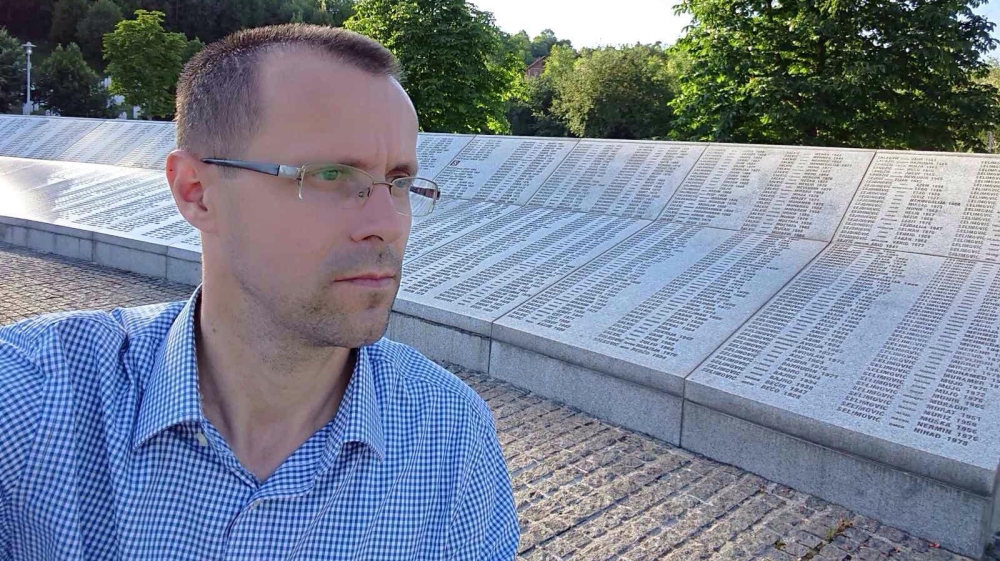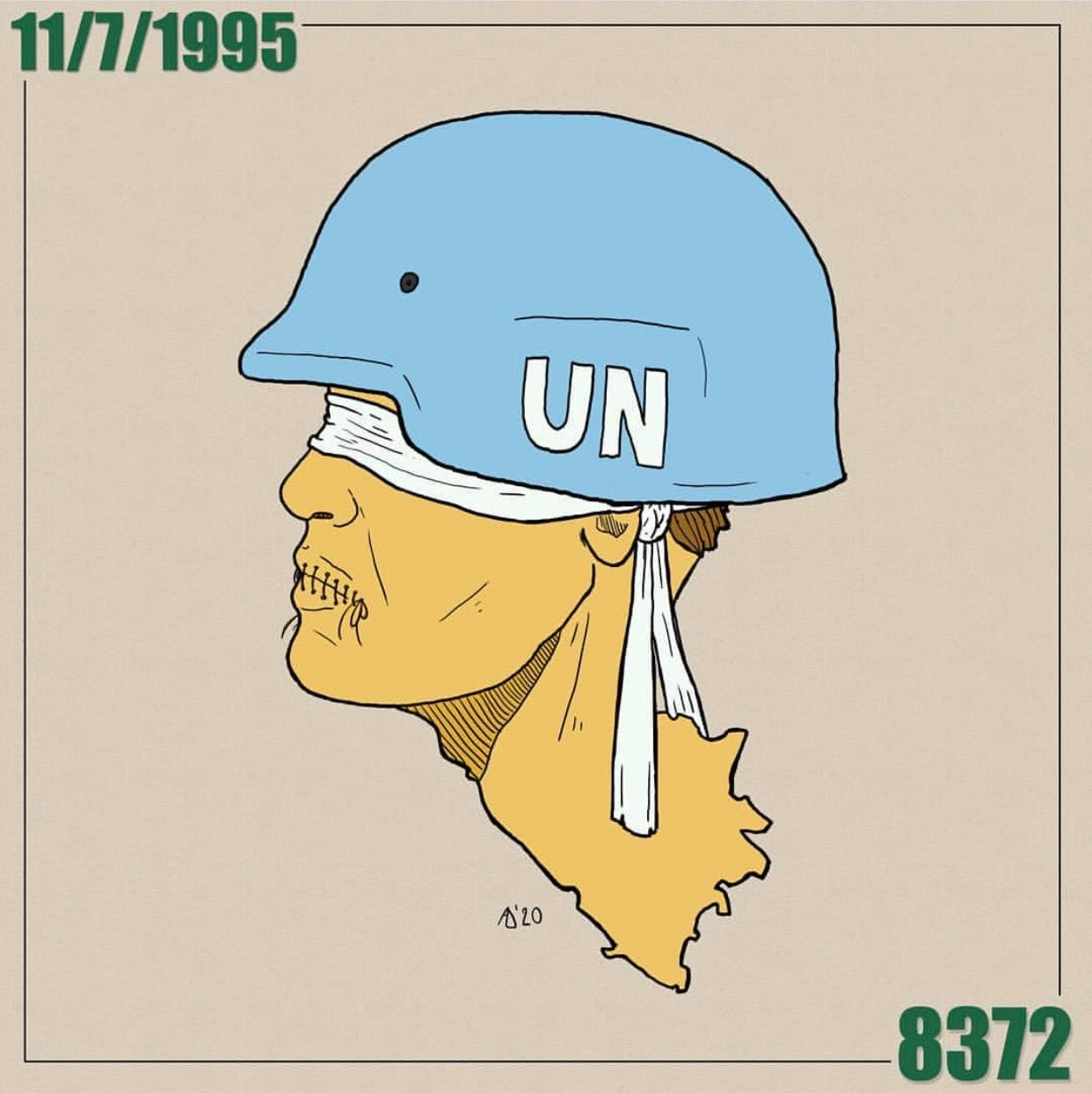At 4:15pm on July 11, 1995, Bosnia’s Srebrenica – a United Nations-protected safe zone where about 50,000 Bosniaks had sought refuge – fell to advancing Serb forces, who claimed the town for a Greater Serbia.
“Here we are … in Serb Srebrenica. On the eve of yet another Serb holiday, we give this town to the Serb people as a gift,” Bosnian Serb general Ratko Mladic said at the time in front of the TV cameras.
“Finally, after the rebellion against the dahis, the time has come to take revenge on the Turks in this region,” he said, using the term “dahis” to refer to renegade janissary officers who ruled Serbia during the Ottoman Empire.
By Turks he meant Muslims and in the ensuing days, Bosnian Serb forces along with a Serbian paramilitary unit killed more than 8,000 Bosniak men and boys in a massacre that constituted a genocide, according to the UN judges.
The Serb forces used bulldozers to throw the bodies in numerous mass graves. Their remains are still being searched for.
About 30,000 Bosniak women and children were deported in just two days. Thousands of women and girls were raped.
Two survivors of the genocide have shared with Al Jazeera their stories and their perspective on the future.
Nedzad Avdic, 42
About 15,000 Bosniaks joined in the trek, forming a column, but the chances of making it out alive were slim.
The trek is known as the Death March, as the column of men and boys was regularly ambushed and shot at with heavy artillery by the Serb forces. Only 3,000 Bosniaks survived – less than a quarter.
Avdic lost his father in the crowd and never saw him again.
Through a megaphone, the Serb police and army told the survivors from the field below to come down, promising that they would not be killed and that they would be reunited with their family.
When a group of them walked down, the injured were shot and killed and the rest, including Avdic, his teacher and classmates were loaded onto a truck, where they spent the night.
On July 14, in a row of trucks, Serb forces began transporting them and others they captured to an unknown location.
“I remember as we were going through [the nearby town of] Bratunac, before they covered the truck with tarpaulin, many [Serb] residents were watching us [being taken away] from their balconies, so people can’t say today that they didn’t know or they didn’t see anything,” Avdic said.
They were driven to a school. Group by group, they were taken out of the classrooms to be executed in front of the school.
“Exiting the school, I saw piles of dead people to my left and right. My blood froze and in this moment, I realised that it was the end,” Avdic said.
He and his group were taken to a dam 10 minutes away.
“I went with my head down, aware that I’ll be killed. When I reached my spot [and looked up], I saw rows and rows of dead people lying in front of us.”
The group was told to lie down. The next thing Avdic remembers is that he was trembling, with the right half of his chest and stomach in pain as he had been shot thrice, and another bullet had hit his right hand.
When the Serbs set the next row of five victims to be executed behind him, they were shooting everywhere and another bullet hit his foot.
“It was the fiercest pain. I really wanted to die. I was in a state between life and death … I was praying to God for them to come and kill me, but I didn’t dare call out to them.”
Avdic could smell the gunpowder in the air. Those who were still alive were howling from the pain, which stopped once the soldier shot them again.
“In that moment, I was waiting to die. I couldn’t take it any more,” Avdic said.
While the soldiers left to get more men and boys to kill, Avdic noticed someone moving in the rows in front of him.
The two headed over to a channel nearby – Avdic, crawling all the way – where they hid while the next truck arrived and continued with the mass killing.
Once the massacre was over, the two crossed into a village, where they were taken to a military hospital nearby.
Avdic’s father and uncle did not survive the genocide.
In 2007, Avdic returned to Srebrenica where he lives with his wife and three daughters. At first, it seemed the situation was headed in a positive direction, but this was short-lived.
According to a 2018 poll, 66 percent of Serbs in Republika Srpska, Bosnia’s Serb-run entity, deny the genocide. Convicted war criminals are regularly celebrated.
“With the Dayton peace agreement, the international community gave up Srebrenica to Republika Srpska and to those who deny the genocide. I’m disappointed,” Avdic said.
“After 25 years, not much has changed. It’s not that they just deny genocide, but the international verdicts as well. We can’t speak about [what happened] in schools,” he said.
“But we won’t give up. We didn’t even give up in 1995 when they were killing almost all of us. I still have faith and I see there are a lot of younger generations who are fighting against this more and more.”
Almasa Salihovic, 33
Salihovic was running alongside her four older siblings, but as a heavy stream of people were all headed in the same direction, her two eldest siblings Fatima, 19, and Abdulah, 17, got lost in the crowd.
Fatima and Abdulah managed to seek refuge inside the battery factory in Potocari, seen as a safe place.
As it was not possible for tens of thousands of people to stand inside, the UN soldiers closed the door so nobody could go in or out for three days.
The rest of the crowd stayed outside, including Salihovic, her mother and two other siblings.
In the morning of July 13, a line of trucks and buses arrived and a Serb soldier announced: “You’re going to Alija’s [the first Bosnian president’s] territory. First women and children. The men will join you later.”
As the genders were being separated, Salihovic saw UN troops standing by the road.
“None of them reacted in any sort of way to even try to prevent [what was happening],” Salihovic said.
“None of them did anything to even bring attention to what was going on … they knew what was going to happen to the people inside [the factory].”
Salihovic and her family got in one of the buses. Her mother pushed her 15-year-old brother Salih under the seat and threw some clothes on top of him to hide him, as she knew the Serb soldiers would search the bus again.
Hours later, they reached the town of Kladanj, outside Serb control, and stopped at a meadow, which was full of people who were crying and waiting for news of their loved ones.
In the evening, Fatima arrived and found her family, but to their horror, she was alone.
When she said the Serbs did not let Abdulah with her on the bus, their mother fainted amid screams and cries.
About 13 years later, Salihovic received a phone call that 30 percent of Abdulah’s remains had been found in a secondary grave called Cancari near the town of Zvornik.
According to the reconstruction, experts found that Abdulah was shot.
Salihovic and her sisters buried him that year on July 11, 2008, as experts told them it was possible they would never find the rest of his remains.
It took Fatima 25 years to speak about what happened when she detailed her memories in a letter to Salihovic earlier this year.
The letter said a Serb soldier entered the factory, asking all men and boys older than 15 to write their names on the paper signed by a Dutch military commander.
A Bosnian translator also entered the factory and told the Bosniaks a negotiation was going on for their release and that Serb soldiers had demanded from the UN to sign their names.
For two days, they were collecting names, but some people decided not to sign it.
Fatima had debated with Abdulah whether to add his name. In the end, they thought the paper served as proof of existence and could save his life, so Abdulah signed it.
As they were leaving the factory, Fatima described “walking with Abdulah and looking in his eyes, eyes of a boy who knew that he was going to die”.
“She said she didn’t have the feeling that he was blaming her but she simply saw eyes that were saying the last goodbye,” Salihovic said.
In February, Salihovic visited the old factory, now a museum as a translator with a group of students.
She found a file of documents on a table that had a list of names. Turning to the last page, she saw her brother’s name written in his handwriting: Salihovic Abdulah – 1977.
His name was the second-last name on the list, number 238.
‘Hidden attacks’
Posters of Mladic have been put up around Srebrenica and Bratunac, reading: “Thank you General for 11th of July, the day of liberation of Srebrenica.”
“That’s what scares me the most,” Salihovic said. “Even if we don’t have incidents in Srebrenica like physical fights, we still have these hidden attacks which is far more worse.”
“You have people who pretend that they’re nice, they greet you, they’re good. And all of a sudden, you see that they’re part of this [celebration] and that’s terrifying,” she said.
“You have people who would still do the same thing tomorrow if they have the chance and if we don’t speak even more loudly than we do now, then I’m really not sure where this is going.”
Credit: Source link



![Almasa Salihovic [Courtesy of Almasa Salihovic] Almasa Salihovic [Courtesy of Almasa Salihovic]](https://www.aljazeera.com/mritems/Images/2020/7/9/857214015ceb40aaac74c0356ad4f5c0_18.jpg)


